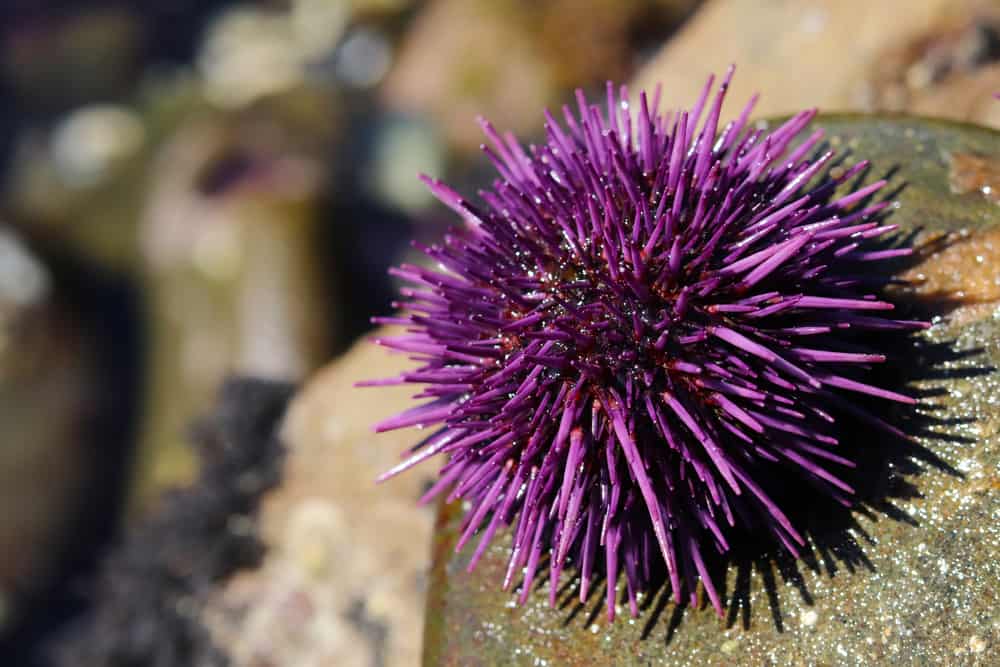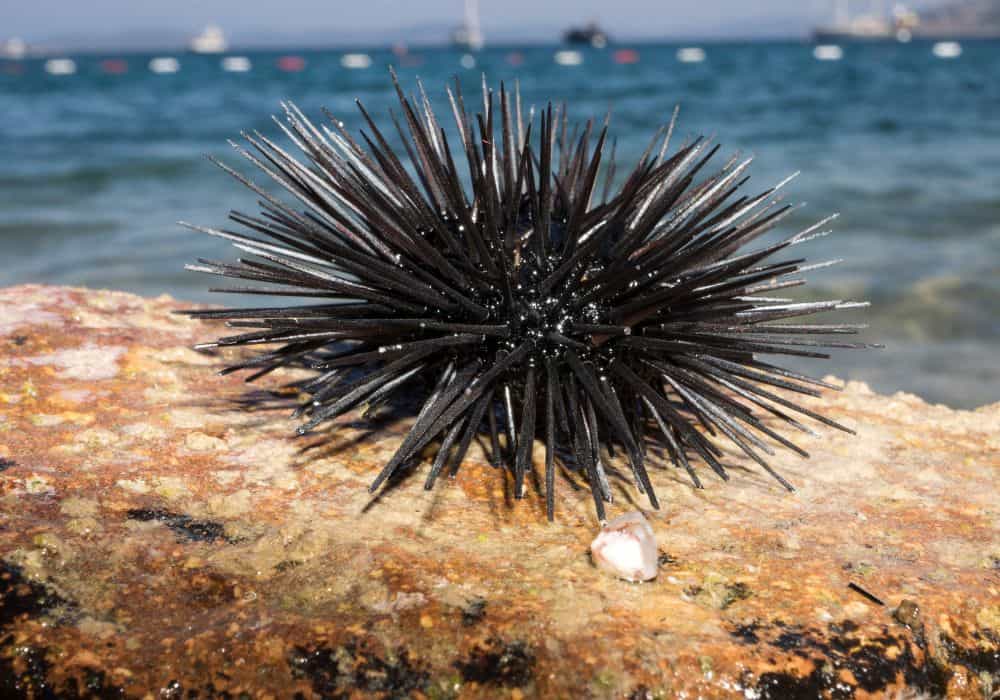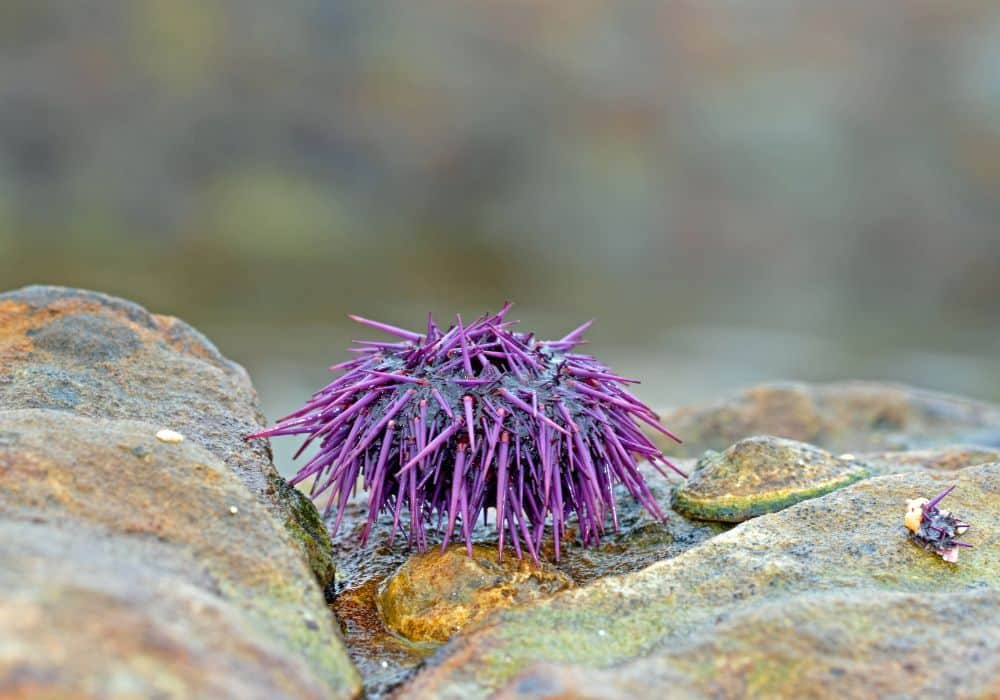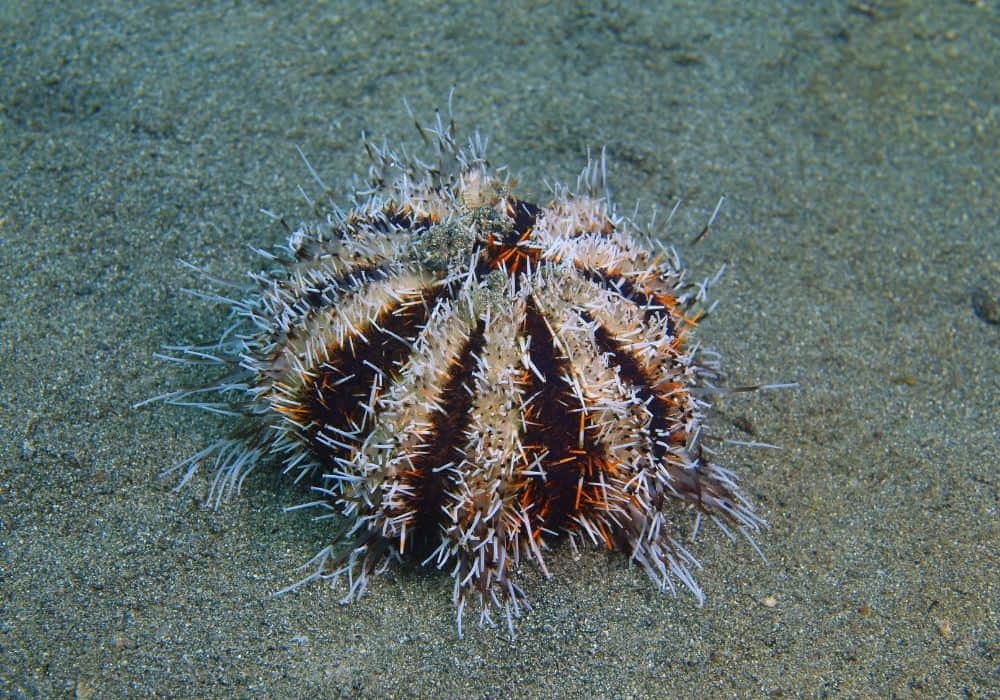Are you fascinated with sea urchins? Well, you are not alone! These sea creatures are such a sight to see, especially with their vibrant colors and distinct textures. While exploring these marine invertebrates, perhaps you may have wondered what sea urchins eat. Let’s get to know more about these distinct animals and get an idea about their main diet.
The Physical Characteristics of Sea Urchins
A circular body full of spikes with tubed feet―this is probably the best description of a sea urchin. But beyond their famed physical features, these marine creatures actually have more unique characteristics.
Sea urchins or echinoids are part of the phylum Echinodermata, which are relatives to sea cucumber and starfish. There are more than 900 sea urchin species all around the world and they are normally classified as either regular (sea urchins) or irregular (sand dollars).
Unlike humans and most vertebrates, they don’t depend on a bone structure. As echinoderms, they can easily support their bodies using their shell-like build referred to as “test”. Their skeleton primarily constitutes calcite, a carbonate mineral that outlines the hardness of the scale.
Their mouth consists of five calcium carbonate plates, which is known as “Aristotle’s lantern”. And while they don’t have visible eyes, they actually use their entire body to respond to light. They have their own version of the Pax6 gene, which supervises the development of their eyes.
Aside from their inimitable structures, sea urchins vary in size and color. They often range between 3 to 36 cm in diameter, depending on their species. As to their colors, the purple sea urchin and red sea urchin are some of the most popular shades. Other common colors are black, pink, green, yellow, and brown.
The Distribution, Habitat & life span of the Sea Urchins
Although sea urchins are ubiquitous, their main habitat is the ocean. They generally live in places with rocky bottoms, from the intertidal zone down to the seabed. Moreover, they are abundant in areas with tropical and temperate waters.
Most sea urchins are found in the ocean, but there are also some that lurk in kelp forests. These underwater areas are highly dynamic and productive ecosystems, which allow sea urchins and other species to thrive.
Since these species typically live in shallow depths of water, sea urchins are among the longest-living creatures on the planet. In fact, they can live up to 100 years old while some may even reach 200 years or more!
A couple of red urchin species found on the Pacific coast were even considered immortal as they were believed to be over 200 years old. This research was printed in the US Fishery Bulletin by scientists from the Lawrence Livermore National Laboratory and Oregon State University.
What do sea urchins eat?
Wild sea urchins
Just like plankton, wild sea urchins feed on algae. They generally protect coral reefs because they prevent these photosynthetic eukaryotic organisms from taking too much sunlight for photosynthesis. Accordingly, this allows corals to flourish.
Because most sea urchins do not have an extensive locomotion range and highly detailed feeding structure, it’s a challenge for them to eat substances with a harder texture. Henceforth, they feed on dead fishes and species that sink to the ocean floor.
Aside from algae and dead fish, sea urchins in their natural territory may eat other creatures that are smaller than them. These include mussels, limpets, chitons, periwinkles, and barnacles, among others. Sessile species that move slowly or those that are always stuck on the seabed are also a part of their food list.
Captive sea urchins
In captivity, sea urchins should have the same diet as they do in their natural habitat. Feeding them the same food helps them adjust seamlessly into their new home―in this case, the aquarium. Copying what they consume in the wild also makes them function properly and extends their lifespan.
So, if you have a pet urchin, let them eat their favorite food like algae and dead fishes. Since sea urchins are generally omnivores, they can also be fed with seaweed. These are remarkable treats, especially with the limited natural food resources inside a tank.
Other recommended options are algae wafers and sinking koi food. Both can easily be bought from pet stores, so try to stack up some for your beloved pets.
Baby sea urchins
Baby urchins, whether in the wild or in captivity, tend to eat a lot. They primarily eat algae and smaller sea creatures mentioned earlier like chitons, barnacles, mussels, and limpets. They also love to feast on seaweed, wherein they can consume more than their body weight.
They do not actively hunt their prey, but just take in substances that float down to the ocean floor instead. And since younger urchins are more voracious, they are very helpful in chomping their way through encroaching algae.
Adult sea urchins
Older sea urchins can easily move across the seabed, allowing them to pursue their prey, which is mostly slow-moving creatures. These include feather stars, sea stars, sea cucumbers, and all the above-mentioned creatures. And of course, you can’t miss out on their most treasured food―algae and dead fishes!
How much do sea urchins eat?
The consumption of sea urchins largely depends on their life stage. As noted previously, younger ones are insatiable, hence a higher percentage of food that they eat. However, some pet owners believe that there’s no need to feed a sea urchin at all if there are naturally-producing algae in the aquarium.
And if there are several fish species that leave bits of food and even wastes within the tank, sea urchins tend to collect and devour these. Their hunger level varies accordingly and may be visible with their movements.
If you see them constantly exploring the container looking for something or staying near the waterline where most algae are situated, this may be a hint that they are hungry. In this case, you need to feed them, perhaps a couple of seaweeds or algae wafers.
Sea urchins’ special eating behaviors
Sea urchins are unique marine creatures that have their own style of eating. They have mouths that resemble that of a beak―but a quintuple one. Aristotle’s lantern is an intricate structure located in the center of its underside.
They use their mouth to move freely, clasp on their prey, and devour their food. They also utilize their mouth to protect themselves from predators.
On top of that, their five calcium carbonate teeth are shelf-sharpening! This means that these can grow naturally in case the previous ones are worn down or lost because of abrasion. The regeneration of a new tooth ensures continuous food consumption.
Since their mouths are on the bottom of their shell, they directly eat anything that falls on the floor. Once the food travels from the mouth to the body, the substances get digested to acquire the needed nutrients. Afterward, the waste is expelled to the top of the shell, which is its anus.
Because of this unique behavior, sea urchins are favored among aquarium owners. These species are widely capitalized to keep the tank clean as well as control the algae population within the aquarium. Henceforth, they are best accompanied by other fish species to make them more functional.
What not to feed sea urchins?
If you own a sea urchin, well, you won’t have a problem with what to feed them. They eat almost anything that floats and touches the floor. There isn’t much restriction on food as they consume alive and even dead ones with the help of their sharp teeth and spiky appearance.
Conclusion
Sea urchins, along with other animal species, are a pivotal part of the marine ecosystem. Therefore, it’s important to feed them properly, especially if they are in captivity. This allows them to flourish and do their part in marine ecology.
FAQ:
1. Do sea urchins eat fish?
Because of the structure of their body, it’s difficult for sea urchins to eat fish. Fishes move around quickly, making it tough for them to prey upon.
Plus, a sea urchin’s mouth is at the bottom of its body, which means it can only focus on food that is on the floor. But of course, if these are slow-moving creatures and probably dead fishes, they can consume them without a problem.
2. Do sea urchins eat coral?
No, sea urchins do not feed on corals. Instead, it helps in eating algae that surround corals. Therefore, both marine animals could be tagged as buddies as they work hand in hand to maintain the needed balance in the marine ecosystem.
3. What are sea urchins eaten by?
Although sea urchins are protected by their hard shells, they are still susceptible to bigger predators like lobsters, octopuses, crabs, and large fishes. Among the large fish species, their most common enemies are wolf eels, sheepshead, and parrotfish. Seagulls and sea otters also prey upon intertidal sea urchins.
Aside from the above-mentioned sea predators, humans are one of the biggest rivals of sea urchins. In fact, sea urchins are widely considered an expensive delicacy in many countries.
In Japan, the gonad, or the orange genital gland inside its shell, is highly valued because of its flavor and exquisiteness. Locally referred to as “uni’, the eggs are usually served raw and are topped on popular sushi dishes.



